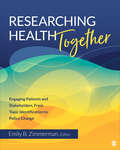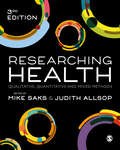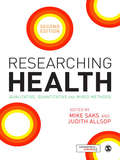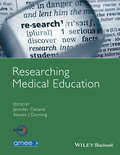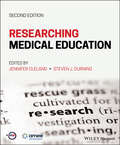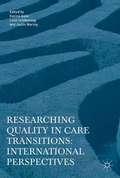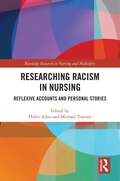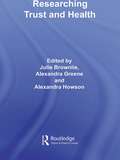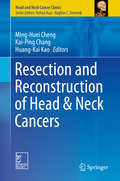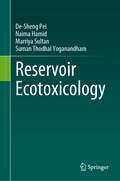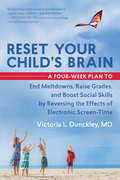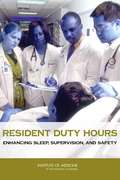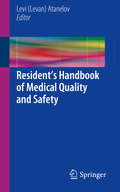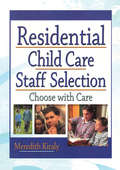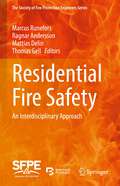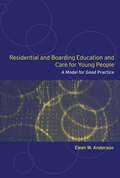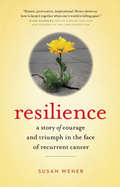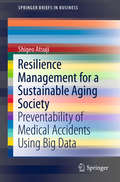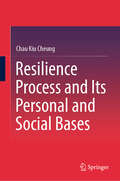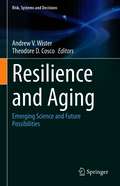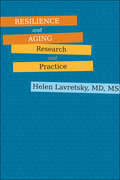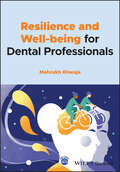- Table View
- List View
Researching Health Together: Engaging Patients and Stakeholders, From Topic Identification to Policy Change
by Emily B. ZimmermanThe challenges of addressing health disparities, the ethical imperative to include stakeholders in research, and the slow translation of research evidence into practice are all driving a movement towards more community-based and participatory approaches to research. Researching Health Together brings together authors who have produced innovative methods or implemented projects focused on different stages of the research process, from question development to evaluation and translation. Editor Emily B. Zimmerman gathers exemplary new methods and projects into one place for the benefit of students designing research projects and proposals, those learning stakeholder-engaged methods, and those involved in implementing and funding stakeholder-engaged projects. Each chapter addresses: how engagement was conceptualized, organized, and implemented; how engagement was evaluated; impacts on processes and outcomes of the project; and facilitators, barriers, and lessons learned. The book serves as a core textbook for courses in community-based health research at the graduate level.
Researching Health Together: Engaging Patients and Stakeholders, From Topic Identification to Policy Change
by Emily B. ZimmermanThe challenges of addressing health disparities, the ethical imperative to include stakeholders in research, and the slow translation of research evidence into practice are all driving a movement towards more community-based and participatory approaches to research. Researching Health Together brings together authors who have produced innovative methods or implemented projects focused on different stages of the research process, from question development to evaluation and translation. Editor Emily B. Zimmerman gathers exemplary new methods and projects into one place for the benefit of students designing research projects and proposals, those learning stakeholder-engaged methods, and those involved in implementing and funding stakeholder-engaged projects. Each chapter addresses: how engagement was conceptualized, organized, and implemented; how engagement was evaluated; impacts on processes and outcomes of the project; and facilitators, barriers, and lessons learned. The book serves as a core textbook for courses in community-based health research at the graduate level.
Researching Health: Qualitative, Quantitative and Mixed Methods
by Professor Mike Saks Professor Judith AllsopSaks and Allsop's Researching Health offers a comprehensive introduction to research methods for healthcare students. The new third edition includes important theoretical updates, and further international content, with contributors covering a number of specialisms and providing perspectives on core topics from the UK, Italy, Japan, New Zealand, Portugal, Canada, and Spain. There are 6 NEW chapters on: Principles of Health Research Methods of Sampling in Qualitative Health Research Qualitative Data Analysis and Health Research Researching Health Care Management Using Secondary Data Online Research in Health Disseminating and Evaluating Health Research The book is supported by case studies, end-of-chapter exercises, annotated further reading, and access to online resources for both students and lecturers, consisting of SAGE journal articles, web links, PowerPoint slides, and teaching notes for each chapter.
Researching Health: Qualitative, Quantitative and Mixed Methods
by Professor Mike Saks Professor Judith AllsopSaks and Allsop's Researching Health offers a comprehensive introduction to research methods for healthcare students. The new third edition includes important theoretical updates, and further international content, with contributors covering a number of specialisms and providing perspectives on core topics from the UK, Italy, Japan, New Zealand, Portugal, Canada, and Spain. There are 6 NEW chapters on: Principles of Health Research Methods of Sampling in Qualitative Health Research Qualitative Data Analysis and Health Research Researching Health Care Management Using Secondary Data Online Research in Health Disseminating and Evaluating Health Research The book is supported by case studies, end-of-chapter exercises, annotated further reading, and access to online resources for both students and lecturers, consisting of SAGE journal articles, web links, PowerPoint slides, and teaching notes for each chapter.
Researching Health: Qualitative, Quantitative and Mixed Methods (2nd Edition)
by Professor Mike Saks Professor Judith AllsopThe second edition of Researching Health covers everything that a student or new researcher will need when starting to conduct their own research in a range of healthcare settings. The chapters guide the reader through each specific qualitative, quantitative and mixed method, and show how these work in practice. In the second edition, the authors place particular focus on the critical appraisal of research - asking not only how different forms of research can be conducted, but also how we can use the research of others effectively. Two new chapters have also been included, on: - Gender and Health Research - Public Health Research A full companion website accompanies the book, with a range of teaching materials for lecturers and online learning resources for students. It is an ideal companion for undergraduate and postgraduate students on health programmes. The book is also valuable reading for researchers, academics, managers and practitioners working across the healthcare field.
Researching Medical Education
by Jennifer Cleland Steven J. DurningResearching Medical Education is an authoritative guide to excellence in educational research in the health professions. <P><P>Presented by the Association for the Study of Medical Education and the Association for Medical Education in Europe, Researching Medical Education includes contributions from a team of international clinicians and non-clinical researchers in health education, representing a range of disciplines and backgrounds. This accessible reference provides readers with the basic building blocks of research, introduces a range of theories and how to use them, illustrates a diversity of methods and their use, and gives guidance on practical researcher development. By linking theory and design and methods across the health profession education research spectrum, this book supports the improvement of quality, capacity building and knowledge generation. Researching Medical Education is the ideal resource for anyone researching health education, from undergraduate, through postgraduate training, to continuing professional development.
Researching Medical Education
by Jennifer Cleland Steven J. DurningRESEARCHING MEDICAL EDUCATION Researching Medical Education is an authoritative guide to excellence in educational research within the healthcare professions presented by the Association for the Study of Medical Education and AMEE. This text provides readers with key foundational knowledge, while introducing a range of theories and how to use them, illustrating a diversity of methods and their use, and giving guidance on practical researcher development. By linking theory, design, and methods across the spectrum of health professions education research, the text supports the improvement of quality, capacity building, and knowledge generation. Researching Medical Education includes contributions from experts and emerging researchers from five continents. The text includes information on: Developing yourself and your practice as a health professions education researcher Methods and methodologies including ethnography/digital ethnography, visual methods, critical discourse analysis, functional and corpus linguistics, critical pedagogy, critical race theory and participatory action research, and educational neuroscience methods Theories including those where relationships between context, environment, people and things matter (e.g., complexity theory, activity theory, sociomateriality, social cognitive theories and participatory practice) and those which are more individually focused (e.g., health behaviour theories, emotions in learning, instructional design, cognitive load theory and deliberate practice) Includes 10 brand new chapters Researching Medical Education is the ideal resource for anyone researching health professions education, from medical school to postgraduate training to continuing professional development. “This is an extraordinary text that combines theory and practice in medical education research. The authors represent the who’s who of medical education research, and their wisdom and insights will help guide novice and experienced researchers alike.” —David M. Irby, Professor Emeritus of Medicine, University of California, San Francisco, USA “Research in health professions education is maturing. This is clearly evidenced by the second edition of Researching Medical Education. In 30 chapters this book takes you on an exciting voyage on research theories and research methodologies. This book is a comprehensive resource for anyone engaging in research in health professions education.” — Cees van der Vleuten, former Director of the School of Health Professions Education, Maastricht University, The Netherlands
Researching Quality in Care Transitions
by Justin Waring Karina Aase Lene SchibevaagThis book is concerned with the complexities of achieving quality in care transitions. The organization and accomplishment of high quality care transitions relies upon the coordination of multiple professionals, working within and across multiple care processes, settings and organizations, each with their own distinct ways of working, profile of resources, and modes of organizing. In short, care transitions might easily be regarded as complex activities that take place within complex systems, which can make accomplishing high quality care challenging. As a subject of enquiry, care transitions are approached from many research, improvement and policy perspectives: from group psychology and human factors to social and political theory; from applied process re-engineering projects to exploratory ethnographic studies; from large-scale policy innovations to local improvements initiatives. This collection will provide a unique cross-disciplinary and multi-level analysis, where each chapter presents a particular depth of insight and analysis, and together offer a holistic and detail understand of care transitions.
Researching Racism in Nursing: Reflexive Accounts and Personal Stories (Routledge Research in Nursing and Midwifery)
by Michael Traynor Helen AllanResearch shows that racism affects the working lives of nurses and nurse academics, as well as healthcare service delivery and outcomes. This book looks at the impact of racism, from experiences of microaggression to discrimination and structural and institutionalised racism. Focusing on the work of five researchers and practitioners who have chosen to address and investigate the racism they experience, witness or observe in the UK’s National Health Service and Universities, this book includes personal reflections on their findings. The substantive chapters are framed by a discussion of policy and research on racism, thoughts on research supervision within this field and a drawing together of the key themes developed through the book. Giving voice to nurses’ and lecturers’ responses to racism in nursing education and practice, this is an important contribution for students, researchers and practitioners with an interest in health inequalities, healthcare organisations, research methods and workforce development.
Researching Trust and Health (Routledge Studies in Health and Social Welfare)
by Alexandra Howson Julie Brownlie Alexandra GreeneThere is currently a lively debate ongoing in society about the nature of trust and the conditions necessary to establish and sustain it. Given the role of trust in bridging uncertainty, it is perhaps not surprising that as our consciousness of risk has increased, the role and nature of trust in social practices has come under growing scrutiny. These developments are particularly relevant to health because participation in health practices is arguably based on and engendered through trust. There is thus a need for empirically based research, which intelligently unravels this complexity to support all stakeholders in the health arena. This multidisciplinary volume of work addresses this gap by contributing substantively to the exploration of trust in the experience, practice and organization of health. It offers an overview of recent scholarship, based on empirical research, which explores the significance of trust in relation to key health-related issues. At the same time, this text examines conceptual themes in relation to trust more generally, including the relationship between trust and auditing, consent, expert knowledges and social capital.
Resection and Reconstruction of Head & Neck Cancers (Head and Neck Cancer Clinics)
by Ming-Huei Cheng Kai-Ping Chang Huang-Kai KaoThis work presents a clear approach for the reconstruction of head and neck cancer excision defects. Starting with a brief historical account of head and neck reconstruction, the principles of resection and reconstruction of head and neck cancer, the book then provides a detailed overview of head and neck reconstruction based on head and neck subsites; various reconstruction techniques; best approaches; and the challenges faced in reconstruction and how to overcome them. Lastly, it discusses future directions in head and neck reconstruction.
Reservoir Ecotoxicology
by De-Sheng Pei Naima Hamid Marriya Sultan Suman Thodhal YoganandhamReservoir construction is the key strategy for water resource management. In recent years, the migration of pollutants and their transformation into the reservoir ecosystem has become a global problem. Intensified anthropogenic activities and unsustainable practices have amplified the pollutant levels in the reservoir. Therefore, this book intends to highlight environmental characteristics of the reservoir, study methods of ecotoxicology, and mechanistic toxicogenetic pathways of pollutants in the reservoir. Adverse outcome pathway (AOPs) model is used to elucidate toxicological effects of reservoir pollutants. Moreover, ecological and human health risks of the Three Gorges Reservoir (TGR), the largest power generation reservoir on earth, and its pollution status are also discussed.
Reset Your Child's Brain: A Four-Week Plan to End Meltdowns, Raise Grades, and Boost Social Skills by Reversing the Effects of Electronic Screen-Time
by Victoria L. Dunckley, MDIncreasing numbers of parents grapple with children who are acting out without obvious reason. Revved up and irritable, many of these children are diagnosed with ADHD, bipolar illness, autism, or other disorders but don’t respond well to treatment. They are then medicated, often with poor results and unwanted side effects. Based on emerging scientific research and extensive clinical experience, integrative child psychiatrist Dr. Victoria Dunckley has pioneered a four-week program to treat the frequent underlying cause, Electronic Screen Syndrome (ESS). Dr. Dunckley has found that everyday use of interactive screen devices — such as computers, video games, smartphones, and tablets — can easily overstimulate a child’s nervous system, triggering a variety of stubborn symptoms. In contrast, she’s discovered that a strict, extended electronic fast single-handedly improves mood, focus, sleep, and behavior, regardless of the child’s diagnosis. It also reduces the need for medication and renders other treatments more effective. Offered now in this book, this simple intervention can produce a life-changing shift in brain function and help your child get back on track — all without cost or medication. While no one in today’s connected world can completely shun electronic stimuli, Dr. Dunckley provides hope for parents who feel that their child has been misdiagnosed or inappropriately medicated, by presenting an alternative explanation for their child’s difficulties and a concrete plan for treating them.
Resident Duty Hours: Enhancing Sleep, Supervision, and Safety
by Institute of Medicine of the National AcademiesMedical residency in the United States aims to prepare recent medical school graduates to practice medicine independently. One fundamental requirement of resident education is in-depth, firsthand experience caring for patients. During the three to seven years of training, residents often work long hours with limited time off to catch up on their sleep. They can experience fatigue on the job, contributing to increased errors and accidents. However, many medical educators believe extensive duty hours are essential to provide residents with the educational experiences they need to become competent in diagnosing and treating patients. Resident Duty Hours: Enhancing Sleep, Supervision, and Safety, a December 2008 report from the IOM, asserts that revisions to medical residents' workloads and duty hours are necessary to better protect patients against fatigue-related errors and to enhance the learning environment for doctors in training. The report recommends that residency programs provide regular opportunities for sleep each day and each week during resident training. In addition, it recommends that the Accreditation Council for Graduate Medical Education provide better monitoring of duty hour limits and that residency review committees set guidelines for residents' patient caseload. Patient handover procedures and supervision of residents should also be strengthened. Until these changes take place, residency programs are not providing what the next generation of doctors or their patients deserve.
Resident's Handbook of Medical Quality and Safety
by Levi Levan AtanelovDrive to provide high value healthcare has created a field of medical quality improvement and safety. A Quality Improvement (QI) project would often aim in translate medical evidence (e. g. hand hygiene saves lives) into clinical practice (e. g. actually washing your hands before you see the patient, suffice it to say that not all hospitals are able to report 100% compliance with hand-hygiene). All doctoral residents in the United States must now satisfy a new requirement from the American College of Graduate Medical Education that they participate in a QI initiative. However, few departments are equipped to help their residents develop and implement a QI initiative. Resident's Handbook is a short, not fussy, and practical introduction to developing a QI initiative. Meant not only for residents seeking to jump-start a QI initiative but also for attending physicians looking to improve their clinical practice, residency program directors and even medical students already eyeing what residency training holds for them; the book introduces and explains the basic tools needed to conduct a QI project. It provides numerous real-life examples of QI projects by the residents, fellows and attendings who designed them, who discuss their successes and failures as well as the specific tools they used. Several chapters provide a more senior perspective on resident involvement in QI projects and feature contributions from several QI leaders, a hospital administration VP and a residency program director. Though originally designed with physicians in mind, the book will also be helpful for physician assistants, nurses, physical, occupational and speech language pathology therapists, as well as students in these disciplines. Since no QI intervention is likely to be successful if attempted in isolation more non-physician clinicians are joining the ranks of quality and safety leadership. Therefore several non-physician clinician led initiatives included in the manuscript constitute an integral part of this book. The book serves as a short introduction to the field of medical quality improvement and safety emphasizing the practical pointers of how to actually implement a project from its inception to publication. To our knowledge this is the first concise do-it-yourself publication of its kind. Some of the topics covered include: how to perform an efficient literature search, how to get published, how to scope a project, how to generate improvement ideas, effective communication, team, project management and basic quality improvement tools like PDCA, DMAIC, Lean, Six Sigma, human factors, medical informatics etc. . Although no substitute for the services of a trained clinical statistician, chapters on statistics and critical assessment of the medical literature familiarizes residents with basic statistical methodologies, clinical trials and evidence based medicine (EBM). Since no QI project is complete without providing evidence for post-intervention improvement we provide a short introduction to the free statistical language R, which helps residents independently run basic statistical calculations. Because much of QI involves assessment of subjective human experiences, there is also a chapter on how to write surveys. Resident's Handbook of Medical Quality and Safety is not an exhaustive QI textbook but rather a hands-on pocket guide to supplement formal training by other means.
Residential Child Care Staff Selection: Choose with Care
by Meredith KiralyHere's vital information on making the right recruitment choices, getting the best staff, and avoiding potential abusers! "More than a set of procedures, good staff selection practice is about a set of principles that embody particular attitudes to the task. If we achieve these basic principles, we will go a long way towards eliminating selection errors and the risk of abuse that follows such errors." -Author Meredith Kiraly Residential Child Care Staff Selection: Choose With Care draws upon international research and the experience of practitioners to help you improve your ability to recruit the best staff. With a minimum of jargon, this book covers the range of selection methods and advocates a considered-but not cumbersome-approach that uses more than one method of assessing skills. It illustrates management techniques that reduce the likelihood of abuse and will show you how to avoid recruiting potentially abusive individuals. Residential Child Care Staff Selection: Choose With Care provides insightful background information, examining the developmental needs of children; issues in the care of children away from home; abuse and pedophilia; and legal and ethical issues. Then the book discusses in more detail research findings which underpin key principles of good care and good staff selection, and best practice in a range of recruitment and selection practices. You'll also find a recruitment guide for all organizations that work with children and young people. The recruitment guide thoroughly examines the challenges and pitfalls of the recruitment process and will help you identify those who are most fit for this difficult yet extraordinarily rewarding career, and avoid recruiting those most likely to be abusive. This valuable book also includes four helpful appendixes that provide: examples of situational and behavioral questions to use in interviews Equal Employment Opportunity guidelines for acceptable and unacceptable interview questions a profile of a skilled residential child care worker that you can use to judge whether candidates measure up sample staff selection forms-job descriptions, application form, a short-listing grid, job interview schedule, interview performance rating form, a reference check proforma, and a selection report
Residential Fire Safety: An Interdisciplinary Approach (The Society of Fire Protection Engineers Series)
by Marcus Runefors Ragnar Andersson Mattias Delin Thomas GellThis book provides a comprehensive overview of deaths and injuries from residential fires as well as the most up to date information on evidence-based approaches to reduce this problem. The volume serves as a guide for professionals working in the field of fire prevention and as a textbook for instruction in universities and fire service schools. The authors’ interdisciplinary approach, where public health methodology is combined with fire protection engineering, medicine, and policy science, is quite distinctive outside of the technical literature devoted to larger scale fire events. Traditional textbooks on fire protection tend to describe the problem as purely technical, whereas in essence it is a problem of human vulnerability. In this book, readers will find lucid and rigorous descriptions of various risk groups and effective preventive measures that are effective, both in general and with respect to the different risk groups. They will also find work processes to facilitate risk reduction. Summarizing state-of-the-art knowledge and giving guidance for the future, both in terms of preventive efforts and ongoing research, Residential Fire Safety: An Interdisciplinary Approach, is ideal for students, educators, and practitioners of residential fire protection.
Residential Institutions in Britain, 1725–1970: Inmates and Environments (Perspectives in Economic and Social History #27)
by Jane HamlettThe essays in this collection explore both organizational intentions and inhabitants' experiences in a diverse range of British residential institutions during a period when such provision was dramatically increasing.
Residential and Boarding Education and Care for Young People: A Model for Good Management and Practice
by Ewan AndersonThis innovative book identifies the key elements of good management and practice common to all residential child care settings - whether hospital unit, boarding school, children's home, special school or custodial care establishment - and important variations between the different settings. Using a model developed under the auspices of the Rowntree Foundation, it provides managers with a coherent framework for understanding the different facets of their role and the outcomes they are aiming to achieve. Major components of the model are:· the environment· the legal framework· developmental issues· time-related issues.In each case the salient factors for practice and management are identified and discussed. Good Practice Education and Residential Care of Children offers a model which can be readily applied to training, assessment of standards, inspections, and research and development. Based on the latest research and reflecting the national drive towards evidence-based standards, it will be an invaluable support to managers in training and practice.
Resilience
by Susan WenerSusan Wener survived cancer not once, but twice. The first time she followed the traditional route of surgery and chemotherapy. The second she went renegade, stepping out into the field of alternative medicine. This book brings to life a journey of more than 30 years, years filled with joy, as well as incredible physical, psychological, and spiritual challenges. As an educator and therapist who helps individuals cope with life-threatening illness, Wener brings a unique perspective to this story. As both a therapist and a patient, she discovers that what is most successful is medical care that is integrated, taking the whole patient into account, not just the disease in isolation. In prose that is both funny and profoundly moving, Wener takes us on her extraordinary journey to wellness and wisdom. She shares her innermost feelings with honesty, insight, and humor. She reminds us that life is filled with endless possibility, that hope and wishful thinking not only help us keep our heads above water but are essential to our sanity, and that what makes us magic is our ability to pick ourselves up every time we fall.
Resilience Management for a Sustainable Aging Society: Preventability of Medical Accidents Using Big Data (SpringerBriefs in Business)
by Shigeo AtsujiThis book utilizes big data to undertake a cluster analysis of medical accidents. Highlighting shared worldwide accident patterns, it represents a first step toward reducing the incidence of accidents through kaizen innovation driven by information and communications technology. This initiative comes against a background where medical accidents are currently the third largest cause of death after heart attack and cancer, making accident prevention an urgent concern. With the objective of preventing these accidents, which negatively impact numerous different stakeholders, and based on interdisciplinary research, the book examines (1) the application of data mining to identify shared accident patterns; (2) proposals for system improvement and organizational innovation aimed at risk and resilience in crisis management; and (3) the use of a global platform to achieve sustainability in the Internet of Medicine (IoM).
Resilience Process and Its Personal and Social Bases
by Chau Kiu CheungThis book is to elucidate personal and social bases for personal resilience, thus addressing the issue concerning the predominance of social factors in shaping resilience. Essentially, the book starts with a clarification of resilience as a phenomenon rather than a trait. The clarification also identifies the personal bases in terms of the resilience process, which specifies belief about resilience as a precursor to learning about resilience, action for resilience, and resilience successively. To justify the personal and social bases, the book expounds the analytical-functionalist framework to specify voluntaristic and deterministic mechanisms to perform the four requisite functions of goal attainment, adaptation, integration, and latency. Equipped with the conceptual and theoretical grounds, the book proceeds to scrutinize the effects of personal and social factors on resilience and its process. The personal factors include personal background characteristics, personality, functional disability, and various beliefs, whereas the social factors include experiences of caring, peace, violence, and social exclusion in society, kindness, sociability, and aid from other people, and social capital. The scrutiny engages five databases about 6.948 Chinese people in Hong Kong and neighboring Chinese cities, composed of the public, service users, older adults, students, and people with visual impairment. Overall, the book presents ample theoretical and empirical substances to clarify the genesis of resilience.
Resilience and Aging: Emerging Science and Future Possibilities (Risk, Systems and Decisions)
by Andrew V. Wister Theodore D. CoscoOlder aged adults face many adversities over the later life course. This edited volume will address the ways in which seniors bounce back from different types and combinations of adversity – termed “resilience”. While research has been accumulating that identifies inherent abilities and external resources needed to adapt and navigate stress-inducing experiences among aging and older adults, gaps remain in understanding the unique elements and processes of resilience. A series of chapters included in this book will address several overarching questions: why do some older individuals/families/communities adapt to adversity better than others; what are modifiable behavioral protective/risk factors related to resilience; and how can we foster resilience at the individual/community level and which approaches show the most promise?The spectrum of aging-related challenges and responses addressed in this book include: mental health; physical/functional health problems; multimorbidity; socio-economic deprivation; social isolation and loneliness; cultural dimensions of loneliness; housing/homelessness problems; and environmental disasters. This book presents cutting-edge science at the conceptual, methodological, empirical and practice levels applied to emerging resilience sub-fields in gerontology. It will also present potential areas of future research, policy and practice linked to these areas.During a period of the most rapid population aging in the US, Canada and many other nations, coupled with heightened global socio-political change, extending our knowledge of resilience will help society to make important adjustments to maximize health and wellness of older individuals. Supporting and enhancing resilience through technological, social and/or community-level advances in geroscience will help those facing adversity to thrive by harnessing, stretching, and leveraging a wide array of potential resources. The promotion of healthier older populations has far-reaching consequences for health care and social/community support systems, both in terms of public health including pandemic response, and the development and implementation of innovations in treatment and practice guidelines.
Resilience and Aging: Research and Practice
by Helen LavretskyResilience is a key component in maintaining health and happiness in old age.When aging adults struggle with social isolation, financial instability, or the difficult work of caring for a spouse with a chronic illness, their levels of stress can be enormous. But many older adults are living longer and are trying to make the best of their later years despite being more vulnerable to stress. In Resilience and Aging, renowned geriatric psychiatrist Dr. Helen Lavretsky explains how enhanced resilience—which involves positively adapting to adversity in a way that maintains a person’s biological and psychological equilibrium—can counter that vulnerability. She describes how care, practice, and research all can be redirected toward emphasizing the positive aspects of aging and prevention.Lavretsky summarizes the most up-to-date research on resilience, neurobiology, and preventive care. She also describes novel interventions—including yoga, tai chi, meditation, and allopathic techniques—that can help older adults improve their cognition and quality of life. Finally, she explores relevant clinical cases from her practice. Designed for geriatric practitioners, researchers, and family caregivers, this practical book offers critical information on measuring resilience, the role of spirituality in reducing stress, and incorporating resilience-building procedures into clinical practice or everyday life. Throughout, the book’s revolutionary integrative approach aims to amplify personal happiness by allowing aging adults to remain healthy and active while simultaneously reducing the cost of chronic disease to families and society.
Resilience and Well-being for Dental Professionals
by Mahrukh KhwajaResilience and Well-being for Dental Professionals Essential reading for dental professionals and other healthcare workers wanting to build emotional resilience and positive mental health Dentistry is a high-stress profession with elevated rates of anxiety, depression, burnout, suicidal thoughts and self-harm. Chronic workplace stress is a growing concern as it can severely damage the mental health of dental professionals and negatively impact their ability to provide appropriate care. Psychological interventions have been shown to greatly benefit the well-being and emotional resilience of the medical and healthcare community, yet resources that provide preventative tools are limited. Resilience and Well-being for Dental Professionals, is designed not only to combat occupational hazards in Dentistry, such as burnout and compassion fatigue, but also to build resilience, engagement at work and nurture positive mental health through a variety of evidence-based tools. This invaluable guide helps readers utilise tools from the science of well-being (Positive Psychology, Mindfulness, Cognitive Behavioural Therapy and Acceptance and Commitment Therapy), to create happier, thriving careers. It includes: Tools from resilience interventions to help dental professionals implement preventative habits and take steps towards positive mental health Focus on self awareness in recognizing burnout early Positive psychology and well-being exercises, customised for dental professionals, to help you meld together research and application: from journaling and creative exercises to nature-based and activities at work Measure and track well-being using psychological scales Manage difficult emotions, practice mindfulness and self-compassion, develop a culture of kindness and gratitude at work, utilise a growth mindset when upskilling, harness positive leadership and use strengths, with patients and at home Create habits that stick through applying the psychology of goal setting, behaviour change, motivation psychology, work-life harmony and happiness Written by a Positive Psychologist, and Dentist, with more than 12 years’ clinical dentistry experience within a stressful NHS environment, Resilience and Well-being for Dental Professionals is a must-have resource for all dental students, hygienists, therapists, dentists, dental nurses, dental technicians, specialists and allied healthcare workers.
